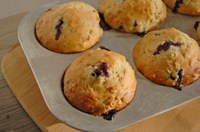Prairie Fare: Are You Ever Confused in the Bread or Cereal Aisle?
(Click an image below to view a high-resolution image that can be downloaded)
By Julie Garden-Robinson, Food and Nutrition Specialist
NDSU Extension
“Which of these is whole grain, anyway?” the shopper asked her companion.
“I’m not sure,” he replied.
“This bread is made with whole grains,” she continued. “Here’s one that has stone-ground wheat.”
“Here’s some gluten-free bread,” he noted.
I wasn’t trying to eavesdrop. I needed some bread, too.
I wanted to hop into their conversation and explain what the various designations mean.
However, I’m not quite that bold, or strange, I guess.
I was standing 6 feet away wearing a face mask, along with everyone else. If I swooped in with the answer, maybe I would have been their hero for the day.
Maybe not.
We nutrition specialists might wear masks during a pandemic, but we do not wear superhero capes when we help with nutrition questions.
Maybe they will read this article and see the answers.
Whole grains contain all parts of the kernel, including the bran, germ and endosperm. Whole-wheat flour and whole-grain oats are examples of whole grains.
To be considered a “whole-grain food,” the whole-grain ingredients must comprise 51% of the total weight of the grains in the product.
“Made with whole grains” means the product contains some whole-grain ingredients, but it doesn’t necessarily meet the legal definition of a whole-grain food. This might seem a little deceptive, but the manufacturers are within their legal limits.
Be sure to do more investigation. Look at the first items on the ingredient statement. These food ingredients are found in highest amounts.
Read and compare the Nutrition Facts labels on the back or side panel of the product. Look for a whole-grain health claim on the package because health claims are monitored closely.
You might see a product labeled “100% whole grain.” In that case, all the grain ingredients are whole grains.
“Stone ground” indicates that the product was milled (or ground) using a particular method. Stone ground isn’t necessarily whole grain.
“Gluten free” means the product has no gluten-containing ingredients, such as wheat, barley and rye. You might even see “gluten free” on bottles of spring water, fruits, vegetables and eggs. These foods never contained gluten in the first place.
That’s legal, according to the Food and Drug Administration.
Gluten is not harmful to the average person, so gluten-free diets are not recommended for the general public. However, those with celiac disease or gluten intolerance may experience harmful or unpleasant effects from gluten consumption.
See https://tinyurl.com/NDSUGluten to learn more about gluten from NDSU Extension.
Yes, all these designations are kind of complicated and sometimes confusing.
To help consumers determine if a product is a whole grain, some manufacturers use a gold stamp from the Whole Grains Council. The stamp shows the amount of whole grain present.
Why are we advised to make half of our grain consumption whole grains, anyway? Whole grains offer some nutritional advantages over refined grains. However, refined grains such as all-purpose flour also provide valuable B vitamins and iron.
Whole-grain foods usually contain more fiber and various beneficial natural plant chemicals that may protect us from chronic diseases.
I noted blueberries on sale at the grocery store, so here’s a good way to use them in a recipe featuring whole-grain oats.
Blueberry and Oatmeal Power Muffins
2 c. all-purpose flour
1 c. oats, quick or regular
2/3 c. sugar
1 tsp. baking powder
1 tsp. baking soda
1/2 tsp. salt
1 1/2 c. honey nonfat Greek yogurt
2 large eggs, lightly beaten
4 Tbsp. unsalted butter, melted and slightly cooled
1 tsp. vanilla extract
1 c. fresh blueberries
Heat oven to 350 F. Coat muffin tin with cooking spray or liners. Combine flour, oats, sugar, baking powder, baking soda and salt in a bowl. Combine yogurt, eggs, butter and vanilla in a second bowl. Fold yogurt mixture into dry mixture; stir to combine completely. Gently fold in blueberries. Spoon into muffin tins. Bake until top is golden and a toothpick inserted in center comes out clean, approximately 20 to 25 minutes.
Makes 16 servings. Each serving has 170 calories, 4.5 grams (g) fat, 4 g protein, 29 g carbohydrate, 1 g fiber and 210 milligrams sodium.
(Julie Garden-Robinson, Ph.D., R.D., L.R.D., is a North Dakota State University Extension food and nutrition specialist and professor in the Department of Health, Nutrition and Exercise Sciences. Follow her on Twitter @jgardenrobinson)
NDSU Agriculture Communication - Aug. 13, 2020
| Source: | Julie Garden-Robinson, 701-231-7187, julie.garden-robinson@ndsu.edu |
|---|---|
| Editor: | Ellen Crawford, 701-231-5391, ellen.crawford@ndsu.edu |




